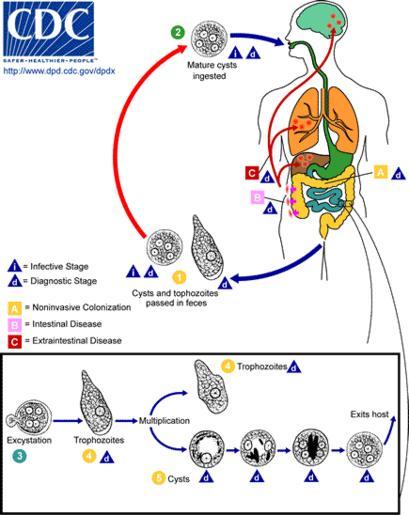MAKE A MEME
View Large Image

| View Original: | Entamoeba_histolytica_Amebiasis_LifeCycle.gif (435x548) | |||
| Download: | Original | Medium | Small | Thumb |
| Courtesy of: | commons.wikimedia.org | More Like This | ||
| Keywords: Entamoeba histolytica Amebiasis LifeCycle.gif Amebiasis Entamoeba histolytica Life Cycle of Entamoeba histolytica Cysts and trophozoites are passed in feces Cysts are typically found in formed stool whereas trophozoites are typically found in diarrheal stool Infection by Entamoeba histolytica occurs by ingestion of mature cysts in fecally contaminated food water or hands Excystation occurs in the small intestine and trophozoites are released which migrate to the large intestine The trophozoites multiply by binary fission and produce cysts and both stages are passed in the feces Because of the protection conferred by their walls the cysts can survive days to weeks in the external environment and are responsible for transmission Trophozoites passed in the stool are rapidly destroyed once outside the body and if ingested would not survive exposure to the gastric environment In many cases the trophozoites remain confined to the intestinal lumen noninvasive infection of individuals who are asymptomatic carriers passing cysts in their stool In some patients the trophozoites invade the intestinal mucosa intestinal disease or through the bloodstream extraintestinal sites such as the liver brain and lungs extraintestinal disease with resultant pathologic manifestations It has been established that the invasive and noninvasive forms represent two separate species respectively E histolytica and E dispar These two species are morphologically indistinguishable unless E histolytica is observed with ingested red blood cells erythrophagocystosis Transmission can also occur through exposure to fecal matter during sexual contact in which case not only cysts but also trophozoites could prove infective DPD CDC http //www dpd cdc gov/dpdx/images/ParasiteImages/A-F/Amebiasis/Amebiasis_LifeCycle gif french Image Entamoeba histolytica Amibiase CycleParasitaire GIF PD-USGov Entamoeba life cycle CDC lifecycles | ||||